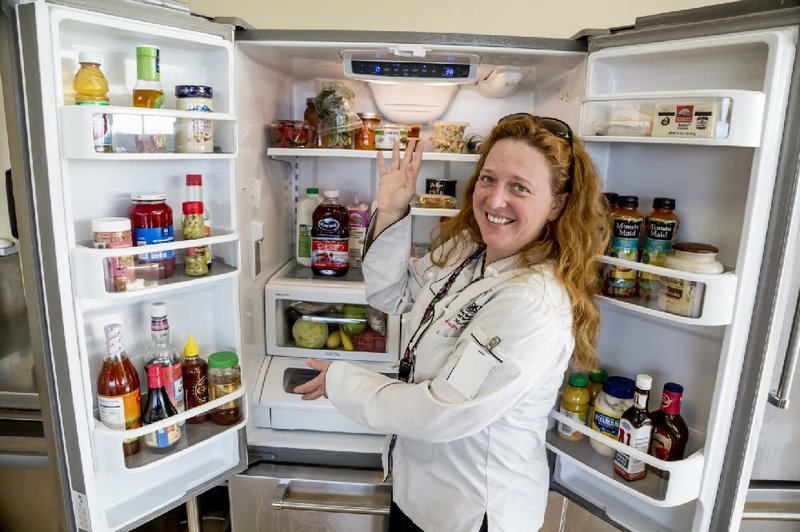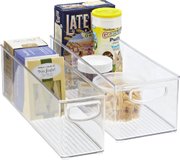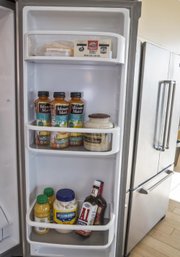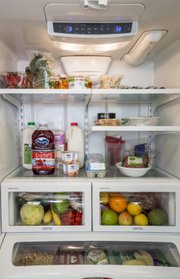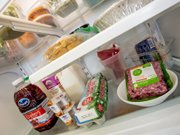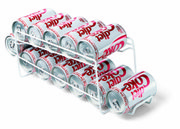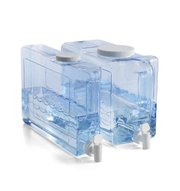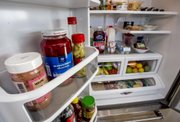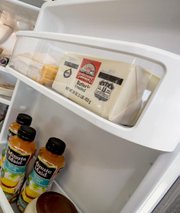The best time to raid the refrigerator is not midnight, but right now for the kind of raid that probably needs doing the most.
Organizing, that is -- because it turns out that a refrigerator is not just a cold box to hold a clutter of things indefinitely. It's a storage system. It works best in certain ways that people commonly ignore.
How often do most people straighten out the refrigerator? The answer might be that National Clean Out Your Refrigerator Day comes just once a year, Nov. 15. By this standard, today's jar of salsa with scarcely a crusty quarter inch at the bottom is good for another nine months. Nobody trusts it, but it stays where it is in the middle of everything -- stuck to the glass shelf, right where the milk should go.
So the milk that belongs on the middle shelf -- the coldest place in the fridge, who knew? -- winds up tucked inside the door, the warmest and worst place to keep milk. Tomorrow's breakfast will be sour cornflakes.
Is this any way to run a kitchen? Not a professional kitchen, a restaurant kitchen. The chef depends on knowing what's in the cooler, where, and that everything is properly kept for safety and convenience.
Food storage is something to learn well at Pulaski Technical College's Culinary Arts and Hospitality Management Institute in Little Rock, where chef Jolie Mosley is lead culinary instructor.
Like a big restaurant, the cooking school has three walk-in coolers, Mosley says: one for meat, one for dairy, one for produce.
The well-organized home kitchen refrigerator is stocked to much the same, three-part effect: top shelf, middle shelf, bottom shelf. Things aren't separated as strictly as in restaurant coolers, but the idea remains to keep everything in the right place, at the right temperature.
In particular, raw meat goes on the bottom. This setup ensures that raw meat in no way touches anything else.
"You don't want raw meat on the top shelf, dripping down on things that are already cooked," Mosley says. Raw meat can be dangerous, a source of viruses and bacteria such as salmonella.
The right temperature is about 40 or 41 degrees, she says -- chilly enough to make food last longer, not so cold that things freeze.
Some refrigerators have built-in thermometers. For those that don't, a simple thermometer to set inside the refrigerator costs as little as $2 or $3. Fancier, digital thermometers go for $10 or $20 on the kitchen aisle.
But the actual temperature varies from shelf to shelf inside the refrigerator, Mosley says, "all different temperatures." Top shelf is generally the warmest, middle the coldest, bottom a bit less cold than the middle.
This helps to determine where things go.
TOP TO BOTTOM
• Mosley recommends the top shelf for all sorts of leftovers -- also berries, bottled water and other drinks, and that nearly-empty jar of salsa.
In fact, she offers a tip for what to do about just a smidgen of something left in the bottom of a jar. Turn the tightly lidded jar upside down, she says. That way, the best of what's left comes out first.
If it's still good to eat, that is.
Homemade or fresh salsa, for example, lasts four to six days in the refrigerator, according to the pepper lovers' website, pepperscale.com. Bottled salsa is good up to a month in the refrigerator, thanks to spoilage-preventing peppers and preservatives. But salsa that smells bad, turns dark or tastes off -- too sharp, maybe -- is nobody's amigo.
• The middle shelf is for things that are apt to spoil quickest if not kept the coldest: milk, creamer, yogurt, eggs.
Dairy products and eggs have sell-by dates on the packaging that provide an idea of how fresh things are. But the sell-by date
assumes proper refrigeration. Leave the refrigerator door open, so the cold air escapes, and things go bad in the refrigerator as sure as cottage cheese in the mailbox.
Refrigerated milk lasts about a week after opening, according to whatscookingamerica.com. Refrigerated eggs are good for about three weeks after purchase, according to the American Egg Board at incredibleegg.org.
• The bottom shelf is best for raw meat, and Mosley doesn't trust the grocery store's plastic-wrapping to be sure a package of meat won't leak. She places packaged meat in a bowl.
Ground meats and seafood are good for a day or two in the refrigerator, according to the U.S. Department of Health and Human Services at foodsafety.gov. Roast and steaks: three to five days. Cooked: three to four days.
But shelves aren't everything. Today's refrigerator has more added storage space than flying first class: vegetable bins and crispers, and racks inside the door. Or in case of double doors -- all the more racks and reason to wonder, what goes?
INS AND OUTS
Some things likely to be found in the refrigerator probably don't need to be there, and other things that many people leave out probably need to go in.
Mosley leaves out, for example, potatoes and tomatoes. Refrigeration makes them taste "mealy" to her. Refrigerated bread, she rates "mushy," a shameful thing to do to bread.
These are preferences, not absolute rules -- well, except for bread, which she recommends as worth a try. See if tomatoes last as long and taste better out of the refrigerator.
"Try side by side," she says -- refrigerated and not -- "and see which you like best."
Lettuce and apples are better refrigerated, she says. Grapes like to chill out, too.
Mayonnaise is a point of contention.
"All Carolina folk are crazy for mayonnaise," as Tom Robbins wrote in praise of the "outright majestic" condiment in Villa Incognito, and not just Carolinians.
Old-time Southern cooks in general are apt to say mayonnaise won't go bad, although made of egg yolks. The Association for Dressings and Sauces agrees at dressings-sauces.org: The creamy white spread remains "perfectly stable" at room temperature.
The association cites vinegar and pasteurization as reasons not to worry. Besides, some mayonnaise comes in squeeze bottles, and the well-known rule of picnic-packing holds that anything in a squeeze bottle is good to go.
But Mosley refrigerates.
"Why take a chance?" the chef says, and rules the same even on mustard and ketchup. These things have to go somewhere, after all. The bottles fit nicely in those racks inside the refrigerator door, along with anything else that might raise a question.
Soy sauce? "Read the label," she says: her guide to any question about a specific product. Jelly, peanut butter or pickle relish, what does the label say?
The soy sauce label says refrigerate. Really? According to what fortune cookie?
Soy sauce won't spoil, according to the Kikkoman company, maker of soy sauce and rice vinegars at kikkomanusa.com. But "once opened, the soy sauce will start to lose its freshness, and the flavor will begin to change." Fridge it, and the "flavor and quality will remain at their peak for a longer period."
REFRIGERATION GRADUATION
Like an overstuffed suitcase too full to close, an over-cluttered refrigerator loses efficiency. The cold air needs room to flow, Mosley says.
"You don't want to overcrowd. You need for the air to circulate."
Beyond the basics of a cold box with a light that comes on when the door opens, she leaves aside the extra gadgetry options of a refrigerator as mostly "personal preference."
One extra worth having is an alarm that beeps if the door is left open too long. It discourages those long, meditative gazes into the refrigerator that go on past remembering what the seeker is trying to find. And it warns if the door didn't quite shut.
At home, she likes that her refrigerator has an ice maker. But touchscreens and music players, and electronic grocery-shopping reminders?
"All personal preference."
STRAIGHTEN UP, COMPANY'S COMING
Refrigerators are highly personal.
Plain or fancy, the refrigerator stands as one of the most beloved home fixtures -- the only kitchen appliance that a person might wake up wanting to meet in the dark.
As the refrigerator magnet quotes country singer Patsy Cline: "Boys, they can't take my refrigerator now. They'll never get my car now. I paid cash for 'em, and they're mine, and I'm keepin' 'em."
HomeStyle on 02/11/2017
